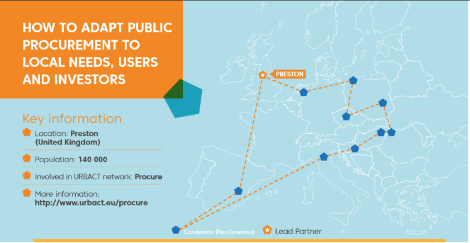Preston (UK) - How to adapt public procurement to local needs, users and investors
2019
When Preston’s economy hit the rocks in 2011, the City Council turned to experiments in community wealth building. Buoyed by the success of these innovations to keep resources in the area they joined the URBACT Procure network to further refine their model and help spread the word.
To download : urbact-citystories-preston1.pdf (690 KiB)

Since the 1980s Preston has faced similar problems to many other parts of northern England. Once a major manufacturing centre, when the factories closed the city found itself in a difficult situation. Despite growth in its valuable service sector, Preston looked to fund further development mainly through external investment, particularly in the commercial and retail sectors.Then, in 2011, a breaking point came. After more than a decade of planning, a GBP 700 million (about EUR 780 million) project to build a new shopping centre in the city centre fell apart. ‘Tithebarn’, as it was known, was supposed to save the struggling community by providing jobs and services. Due to the banking crisis, however, investors lost confidence in the scheme. Finally when one of the major partners, the retailer John Lewis, pulled out, the City Council had little choice but to shelve the initiative. Things looked apocalyptic, “we really had no plan B,” says Councillor Matthew Brown, “and needed to find a solution, a way to be more resilient.”
More than a traditional approach
After months of searching, the municipality found their answer in the field of community wealth building — a set of strategies designed to unlock latent growth from within local economies. A dedicated Preston Procurement Practitioners Group was established whose job was to understand how money was spent within the city using an innovative spend analysis tool. Most importantly it worked to establish how local anchor institutions — such as universities, hospitals, business and housing organisations — could allocate resources in a more strategic way to support communities, where appropriate. Thanks to this tactical procurement strategy, more funds were subsequently spent in the city.By 2015 the benefits of the so-called Preston model were already being celebrated. Yet it was recognised more could be done. This was one of the reasons the city decided to participate in the URBACT Procure network. “It gave us an impetus to continue and an opportunity to expand by including other organisations in our team like the Federation of Small Businesses and Chamber of Commerce,” says Tamar Reay, Economic Regeneration Officer for Preston City Council. The city created a group of local stakeholders, an URBACT Local Group to produce an integrated plan on how to link procurement more effectively to local needs, and how to establish a more collaborative approach with the anchor institutions.Participation in Procure opened the city practitioners’ eyes to innovations in other European cities, complementing their own ethos of community wealth building. From Prague (CZ) they learnt more about how to include social and environmental criteria in their procurement process. From Candelaria (ES) they studied the possible benefits and challenges of participatory budgets. From Satu Mare (RO) they shared strategies for how to work more effectively with local businesses. In all three cases, Preston is exploring how practices learnt from Procure partner cities can be integrated into the municipality’s future plans for the city.Just as importantly, the URBACT network was an opportunity for Preston to raise awareness about its own successful innovations in community wealth building. “The programme has really legitimated what we’re doing by valorising it internationally,” confirms Matthew Brown. Preston’s spend analysis work was recognised as an URBACT Good Practice in 2017, and received a warm reception from hundreds of urban practitioners at the URBACT City Festival in Tallinn (EE) that same year. As a result of its work through Procure, Preston has also become a partner in the EU Urban Agenda Partnership for Innovative and Responsible Public Procurement. This group links urban authorities directly with national governments, observers, and the European Commission.
Sharing the know-how
Across the UK, the Preston model is being wielded as a symbol of resilience, and by some as a prototype for a national alternative to austerity. At the local level, though, the journey is just beginning. The City Council is now working to pioneer further community wealth schemes, based on examples from URBACT Procure network partner cities as well as post-industrial communities in America. Those currently underway include an effort to stimulate the creation of workers cooperatives and form a fully licenced community bank.The Integrated Action Plan, meanwhile, will not just stay on the shelf. “The aim is to continue that work,” reflects Tamar. “We want to make a handbook on procurement. Something which explains what we’re looking for from a buyer’s side, as well as a tendering guide for suppliers.” As these next steps take shape, an even more immediate legacy endures in the bonds among the URBACT Local Group, “that space is not just going away,” insists Tamar. “The anchor institutions will continue to meet and are all interested to continue the Spend Analysis work. We’ve even agreed to collaborate again in future projects.”